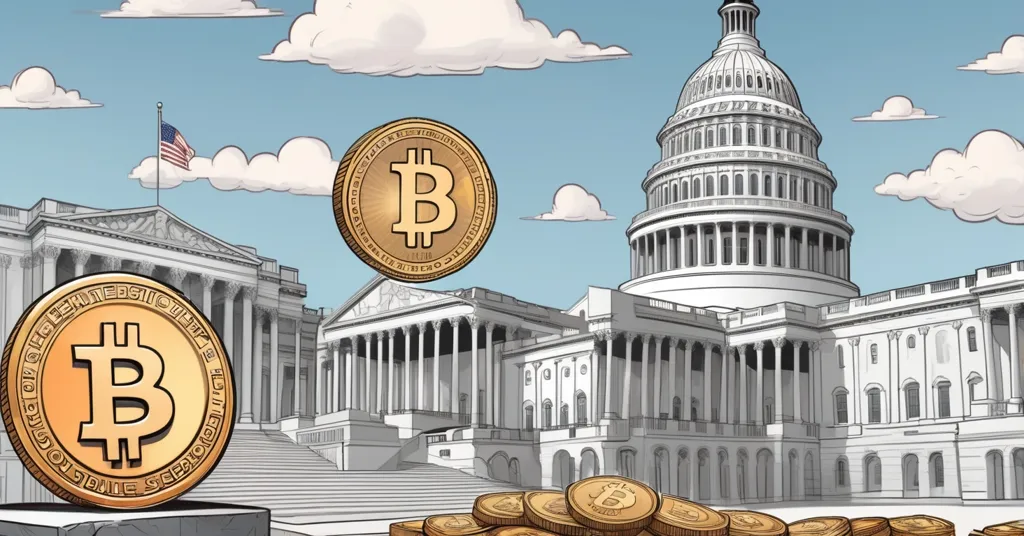Trump Urges Congress for Stablecoin Bill, Establishes Strategic Bitcoin Reserve

President Trump Pushes for Stablecoin Bill to Boost U.S. Dollar and Economic Growth
In a strategic move to bolster the U.S. dollar’s global standing, President Donald Trump has urged Congress to pass a significant stablecoin bill. Addressing the audience at the Blockworks Crypto Conference, Trump highlighted stablecoins’ potential to drive economic growth and praised the vibrant spirit of the crypto community. He further demonstrated his commitment to the sector by signing an executive order to establish a Strategic Bitcoin Reserve, fulfilling a key campaign promise.
- Trump demands stablecoin bill to enhance dollar dominance
- Executive order creates Strategic Bitcoin Reserve
- Crypto industry’s political influence grows in Washington
Trump’s push for the stablecoin legislation is clear:
“I’ve also called on Congress to pass landmark legislation creating simple, common sense rules for stablecoins and market structure.”
He envisions that
“You will unleash an explosion of economic growth, and with the dollar-backed stablecoins, you’ll help expand the dominance of the U.S. dollar.”
His enthusiasm for the crypto community shines through:
“I can already see that the energy and passion of the crypto community is the kind of spirit that built our country.”
The stablecoin bill, designed to regulate dollar-backed stablecoins, has already passed the Senate Banking Committee. These stablecoins are cryptocurrencies pegged to the value of the U.S. dollar, providing a stable and reliable digital currency option. The bill aims to facilitate faster and cheaper payments globally—essentially making sending money around the world quicker and less expensive—while ensuring U.S. financial leadership remains unchallenged. Trump’s vision for the future of finance is optimistic:
“It is exciting to watch as you invent the future of finance. And right here, it’s going to be right here in the USA, the good old USA.”
Washington’s political landscape is shifting, with the crypto industry gaining significant sway. Key figures such as Senators Kirsten Gillibrand and Cynthia Lummis have been driving forces behind crypto-friendly legislation. Lummis credits Gillibrand’s support as pivotal:
“Without her, it doesn’t happen.”
The bipartisan support for the stablecoin bill is evident, with Republican Banking Committee Chairman Tim Scott also backing the initiative.
The crypto industry’s political influence is further underscored by the hefty financial contributions from crypto-backed political action committees (PACs) like Fairshake, which has raised $116 million for upcoming elections. This financial clout demonstrates the industry’s commitment to shaping U.S. policy in favor of digital assets. Yet, amidst this political momentum, the crypto market faced challenges in February, with negative sentiment driven by inflation concerns, tariffs, a $1.5 billion hack, and outflows from digital asset ETFs. These hurdles highlight the volatile nature of the crypto space and the pressing need for robust regulatory frameworks.
Trump’s executive order to establish a Strategic Bitcoin Reserve marks a significant step towards integrating cryptocurrencies into the national economic strategy. This reserve, capitalized with bitcoin obtained from criminal or civil asset forfeiture proceedings, aims to treat bitcoin as a strategic asset similar to gold, without selling it. This aligns with Trump’s broader vision for the crypto sector and reflects a recognition of bitcoin’s potential as a store of value.
The Executive Order on Digital Assets also revokes previous frameworks, indicating a shift towards more supportive and clear regulatory policies. It prohibits Central Bank Digital Currencies (CBDCs) within the U.S., reflecting concerns about privacy and financial sovereignty. The formation of a President’s Working Group on Digital Asset Markets to propose a federal regulatory framework for digital assets, including stablecoins, is another critical development.
Amidst these developments, the crypto industry’s increased political engagement is driven by the potential for regulatory changes with a new administration and congressional control. The industry aims to create a more favorable environment for digital assets, with experts viewing the Strategic Bitcoin Reserve as a recognition of bitcoin’s potential as a strategic asset, similar to gold reserves.
The economic implications of managing digital assets are significant. The fact sheet mentions that premature sales of bitcoin have cost U.S. taxpayers over $17 billion, highlighting the strategic importance of the new reserve and the need for a comprehensive approach to digital asset management.
Key Takeaways and Questions
- What does the stablecoin bill aim to achieve?
The stablecoin bill aims to regulate privately issued, dollar-backed stablecoins, enabling their wider use in financial transactions, which is expected to lead to faster and cheaper payments globally.
- How does Trump see stablecoins contributing to U.S. economic power?
Trump believes that stablecoins will help maintain and expand the U.S. dollar’s dominance, leading to significant economic growth.
- What is the Strategic Bitcoin Reserve?
The Strategic Bitcoin Reserve is a stockpile of Bitcoin and other crypto assets established by an executive order signed by Trump, fulfilling a campaign promise to support the crypto industry.
- Who are the key political figures supporting crypto legislation in Washington?
Key figures include Senators Kirsten Gillibrand, Cynthia Lummis, and Tim Scott, who have been advocating for crypto-friendly laws.
- What role do crypto-backed PACs play in U.S. elections?
Crypto-backed PACs, like Fairshake, are significantly funding political campaigns, with substantial investments aimed at influencing elections and supporting crypto-friendly candidates.



